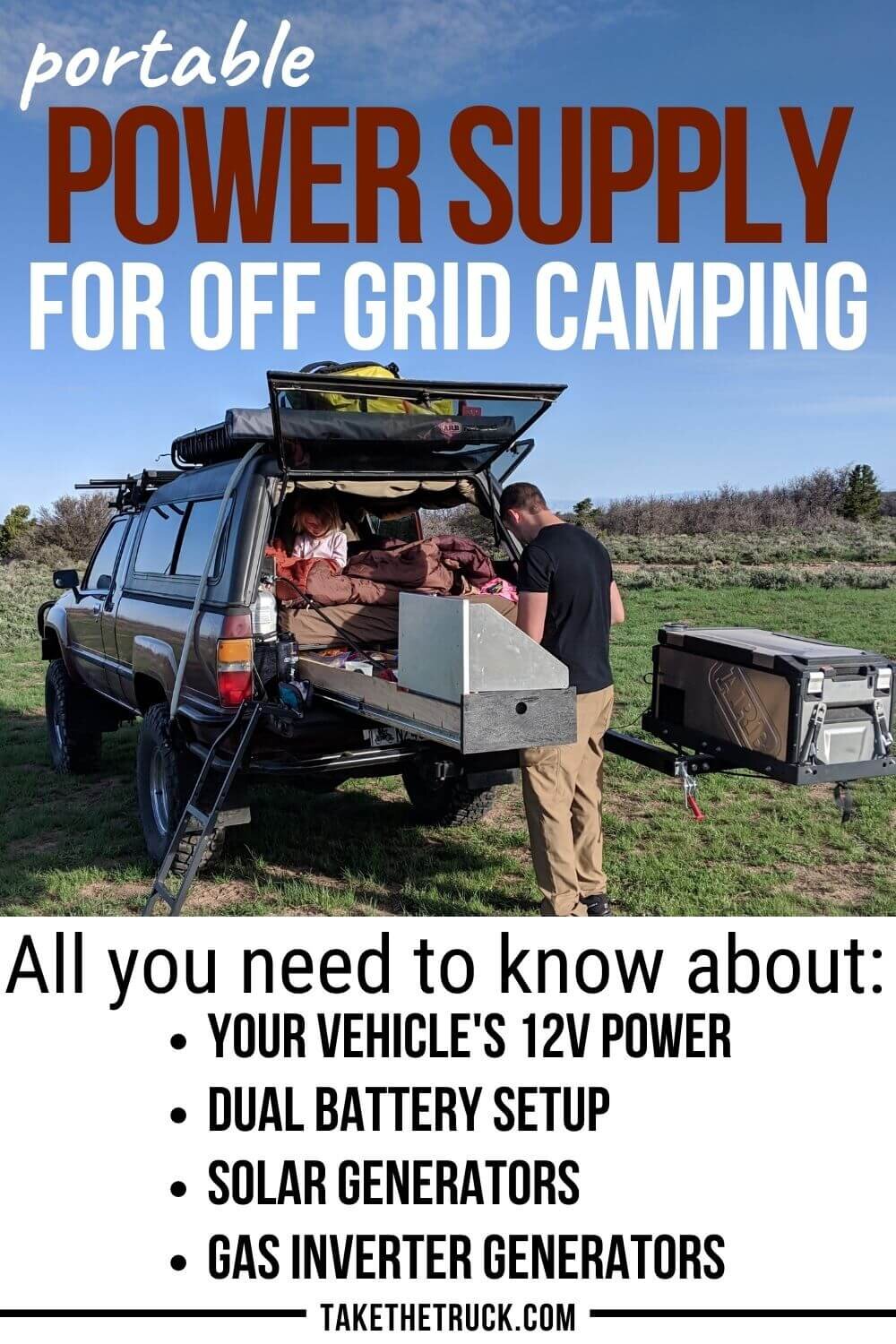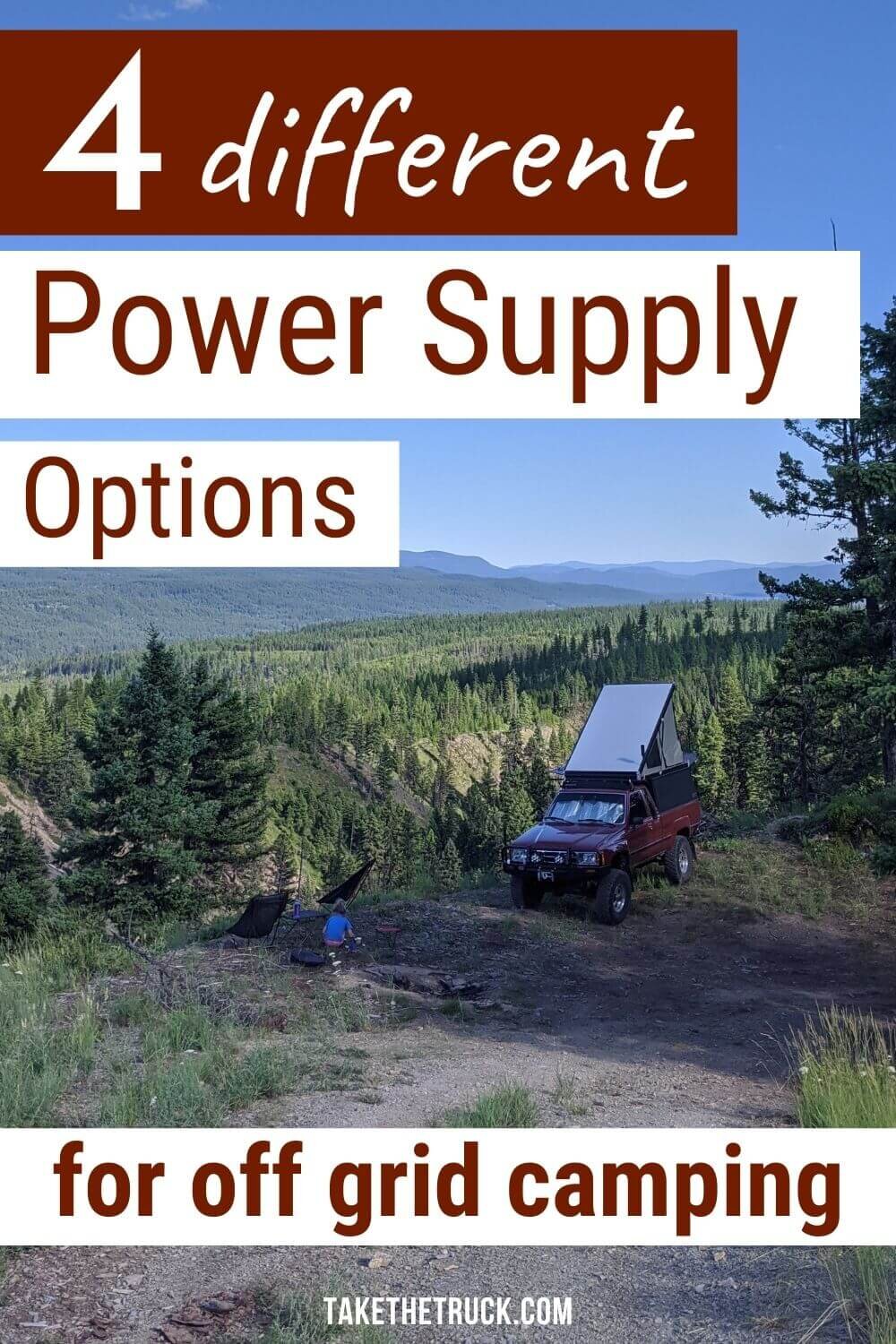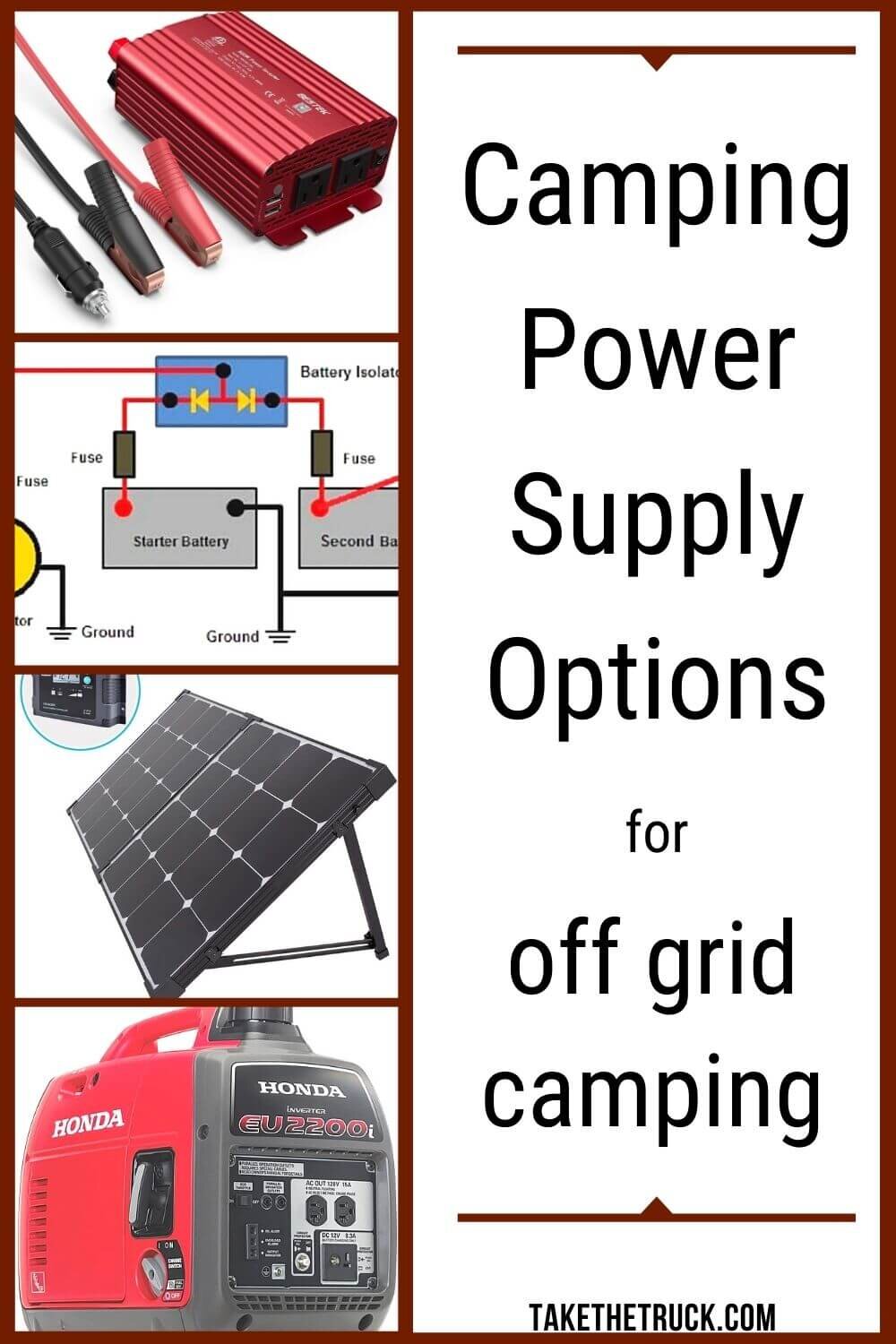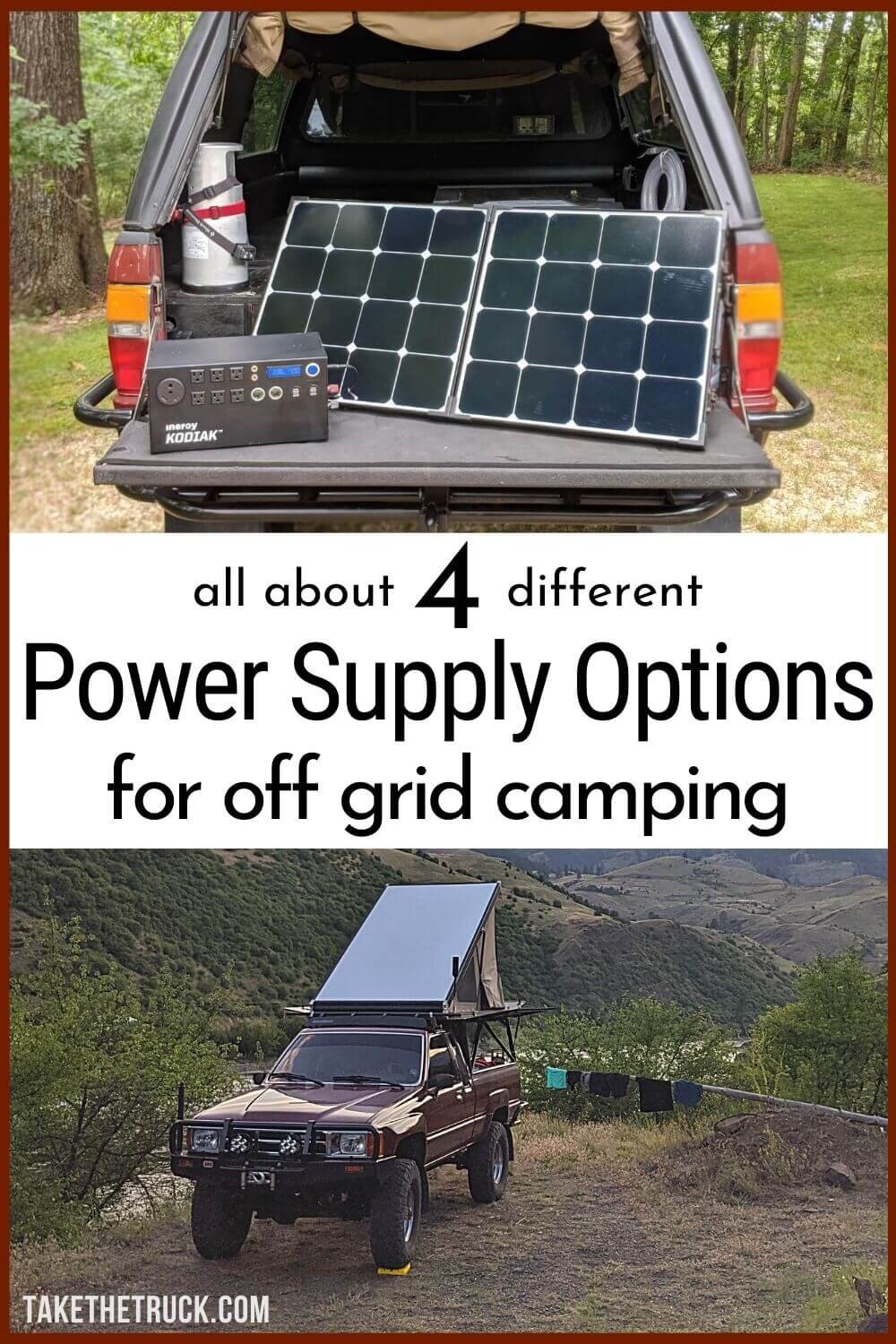Portable Camping Power Part 3 - Selecting a Camping Power Supply
Selecting the right camping power supply is a difficult decision, and can quickly become overwhelming.
In Part 1 of our Camping Power Series we helped you get familiar with the basic principles of camping power. Then, in Part 2, we helped you assess your camping power needs by determining the power consumption of the devices you use while camping, along with evaluating what type of camping you typically do, your average group size, and the length of time you’re usually out.
Phew!
Now, in Part 3, we’ll cover the four most common portable camping power supply options for off-grid camping & boondocking, and help you determine which camping power supply best meets your needs!
*(This post contains affiliate links. This means we may receive a small commission, at no additional cost to you, if you make a purchase through a link. See our full disclosure.)
1. Using Your Vehicle’s Existing 12v Power as a Camping Power Supply
Your vehicle’s electrical system consists of an alternator that charges the vehicle’s starting battery that supplies power to both start and run your vehicle, as well as power some 12v accessories.
You can use your vehicle’s 12v system as your camping power supply if your power needs are low enough, and the best part is - it requires very little investment!
PROS
It’s Cheap! You can charge devices from your vehicle's existing 12v DC outlets (a.k.a. Cigarette Lighter Outlet)
You can use a small Power Inverter* to power some 110v appliances for a short period of time. (We’ve previously used this method to cook our dinners in a small 2-quart crock pot while traveling down the road!)
Good if you have low power requirements (up to 300wh need)
Can be supplemented with a portable solar panel while stopped at camp, using a setup like Renogy’s 100watt Eclipse Portable Solar Panel Briefcase* that comes with built-in charge controller and 12v battery connection
CONS
Capacity is limited to your vehicle’s ability to supply enough power
Could potentially leave you with a dead starting battery, without the ability to start your vehicle, so requires close monitoring of your vehicle’s starting battery charge state
TIP: if you’re considering going this route for your camping power supply, always carry a portable vehicle jumper pack* to avoid being left stranded at camp!
UPDATE 2024 - we now personally use this single-battery Do Everything Overlanding Battery That May Make Dual Battery Systems Obsolete in our Tacoma Overland Truck as our sole camping power supply.
2. Dual Battery System as a Camping Power Supply
This method still uses your vehicle's 12v Power System, but adds an additional isolated battery to supply your camping power needs. If you decide a dual-battery setup is right for you, we have a whole post on dual-battery setups you can check out. But let’s look at the pros & cons of using a dual battery system as your camping power supply.
PROS
By keeping your vehicle's starting battery isolated from your camping power supply, there is no fear of accidentally depleting your starting battery and being left unable to start your vehicle
When installed correctly with the proper power inverter and battery capacity you can supply a wide array of power needs up to 1000+ watt-hour daily need
You can also use a portable solar panel while stopped at camp to supplement your camping power needs with this option as well - we use and recommend Renogy’s 100watt Eclipse Solar Panel Briefcase* that comes with built-in charge controller
CONS
Complexity - it requires the installation of an additional battery (typically lead-acid, AGM, or GEL based) into your vehicle. You can use a dual battery kit like the one pictured here to simplify your installation, or you may prefer paying a professional to handle the install if you’re not comfortable diving into your vehicle’s electrical system
Weight & Size - lead-acid, AGM, and GEL batteries are heavy and bulky so, depending on your vehicle, space for a second battery may be limited.
3. Solar Generators as a Camping Power Supply
Solar Generators are a category of portable camping generator that use a combination of power input options - solar power from the sun, DC power from a vehicle, or AC power from your home - to charge an internal battery, and then provide you with a variety of DC and AC power output options to use as your camping power supply.
They do this by integrating a battery (typically lithium-ion based), a solar charge controller, as well as an AC power inverter all in one compact easy-to-use device!
PROS
They’re light-weight and very portable
They’re virtually silent, emitting no noise-pollution (unlike gas powered generators)
They’re a sustainable camping power supply, emitting no actual pollution!
They’re easy to use right out-of-the-box, little to no wiring is required
CONS
Cost
Also requires additional investment in solar panels
How to Choose a Solar Generator
However with SO many solar generator options on the market, and new manufacturers and models becoming available all the time, it’s hard to tell what to look for. When we were selecting a solar generator for our camping power supply in our truck camping setup, here’s the list of criteria we used to select the best one for our needs:
Usable Capacity - This is typically stated in watts, though some also provide an amp-hour rating.
However, it’s important to note that it is typically not recommended to discharge lithium batteries more than 80% of their rated capacity to avoid damage or shortening their life-span.
So when a solar generator is rated at 1100 watts (or about 90 amp hrs) it actually has a usable capacity of 880 watts (or about 73 amp hours) before the device shuts itself off to protect the battery.
DC Charging Options - Make sure the solar generator has a good 12v car charging option. This will allow you to recharge the generator while in between camp spots or if the sun isn’t keeping up with your power demand.
Max Charge Rate - Make sure that the charge rate is not a bottleneck - meaning that it cannot be charged fast enough to keep up with your power needs while camping
Cost - We’ve found that above a certain price point it may become more practical to go with a traditional dual battery setup or a gas inverter generator.
This is largely dependent on your personal needs and budget, but during our search, anything above a 1400-watt capacity began to lose justification from a cost-benefit perspective.
Power Output (110v AC & 12v DC) - The power inverter in the solar generator converts the DC power stored in the solar generator’s lithium-ion battery to AC power for devices that don’t operate on 12v DC power.
Consider the devices you want/need to power while camping, and make sure the inverter in your solar generator can accommodate the device’s AC power draw (e.g., if you want to use a 1000w microwave, the solar generator’s inverter needs to be rated for more than this amount).
You also want to make sure the DC output of the solar generator offers a high enough amperage for your 12v devices.
Feature Set - Does it have enough 110v AC and 12v DC power outlets for your needs? Enough USB ports? Is it’s battery capacity expandable - meaning, can you tie-in additional batteries if you need? Does the built-in LCD display monitor provide the information you need? Is the internal battery user replaceable?
Review all the solar generator’s features and make sure you’re happy with them. It’s a big investment.
For a more detailed look at using solar generators while camping be sure to check out our guide: Everything You Need to Know About Solar Generators for Camping
Top Three Portable Solar Generators for Camping Power:
Here are our current (updated 2025) solar generator recommendations in order of cost.
Low End Solar Generator:
Goal Zero Yeti 300 - while not practical for running a camping fridge, this 297watt capacity compact portable solar generator is great for overnight or weekend camping trips where you just need to keep your phones, laptops, LED lights, and Camera topped off for the adventure. Plus, unlike previous models, it uses safer and more durable LiFePO4 battery technology and it’s now IPX4 rated weather resistant.
350w (600w surge) AC Inverter
Outlets: 2 - USB-A ports, 2 - USB-C, 1 - 12v DC outlet, 1- 6mm DC outlet, 1 - 110v AC outlet
Max Input: 120 watts
Charge Rate:
Included 500/340watt AC Charger ~ 50min-1.5 hours
DC 10amp 120 watt Car Charger (not included) ~ 2.8hrs
50w Solar ~ 6-10 hours depending on ambient sunlight conditions
Mid-Range Solar Generator:
Goal Zero Yeti 700 - this model is an excellent all-around portable solar generator, with a variety of ports and charging options making it a great camping power supply for everything from weekend off-grid camping trips to weeks-long road trips (provided you spring for the extra car charger and use solar panels to replenish it’s charge). Plus, unlike previous models, it uses safer and more durable 677watt capacity LiFePO4 battery technology and is now IPX4 rated weather resistant.
600w AC Inverter (1000w surge)
Outlets: 2 - USB-A ports, 2- USB-C ports (one PD 100w output equipped), 1 - 12v DC outlet, 1 - 6mm DC outlet, 2 - 110v AC outlet
Max DC Input: 200 watts
Charge Rates:
Included 500watt/340watt AC Charger ~ 1.5-2.5 hours
DC 10amp 120 watt Car Charger (not included) ~ 6hrs
100w Solar ~ 8 hours depending on ambient sunlight conditions
High End Solar Generator:
Goal Zero Yeti 1500X - this extremely versatile solar generator is capable of powering a wide variety of equipment while camping off-grid for extended periods of time, including camping fridges, power tools, blenders, and even a microwave!
2000w AC Inverter
Outlets: 2 - USB-A ports, 2 - USB-C ports, 1 - 12v DC outlet, 2 - 6mm DC outlets, 1- Power Pole DC outlet 2 - 110v AC outlets
Max Input: up to 600 watts (using Power Pole input)
Charge Rates:
Included 120watt AC Charger ~ 14 hours; Or upgrade to the 240 watt charger ~ 7 hours
DC 10amp 120 watt Car Charger (not included) ~ 14hrs
Can be used with Yeti’s Vehicle Integration Kit for fast 454-750watt charging from your vehicle, though we recommend this be professionally installed.
600w Solar ~ 3-6 hours depending on ambient sunlight conditions
4. Portable Gas Inverter Generators as a Camping Power Supply
A gas powered generator is one of the oldest forms of portable camping power supply when wild camping. But the technology has improved vastly over the years, with built-in pure sine-wave power inverters, better sound suppression, and increased fuel efficiency.
Though we typically recommend avoiding gas inverter generators as a camping power supply, this method is still the most practical choice for those with very high power needs while camping off-grid or boondocking.
PROS
Capable of powering high-power usage devices while camping, such as air conditioning units or electric heaters
Not dependent on solar, your vehicle’s 12v power, or grid-power to recharge
Gasoline is generally easily accessible throughout the U.S., and relatively inexpensive
CONS
Noise pollution - though inverter models are significantly quieter than traditional gas generators, they’re still a distraction when wild camping
Weight - most are over 40+ lbs (plus fuel)
Requires additional space for fuel storage
Gasoline is not a sustainable power source
Dealing with noxious gas fumes and exhaust
Top Gas Inverter Generator for a Camping Power Supply:
Honda leads the market in efficient, quiet, and reliable portable gasoline inverter camping generators, and has a solid reputation throughout the camping community.
Though they offer a variety of portable camping generators, we feel the Honda EU2200i mid-range model offers the most value and is the best option for a truck, car, SUV, or tent camping power supply. Primarily because it provides high enough output to operate most portable air conditioning units, while still being reasonably compact.
Honda EU2200i Gas Inverter Generator
Provides 1800w AC Power continuously, and 2200w surge
Runtime: 4 - 9.6 hours per tank (depending on load / power demand)
2 - 120v AC outlets, 1 - 12v battery charging port
Noise Factor: 48-57 dbs (widely considered one of the quietest gasoline generators, though still obtrusively loud)
Weight: 40lbs
We hope this series has provided you with all the information you need to select the right camping power supply for your off-grid adventures, as well as helped you to better understand how each power supply works to provide your power needs while wild camping or boondocking.
Please don’t hesitate to reach out with any questions you might have by dropping a comment down below.
As always, thanks for reading! And if you’d like new posts sent right to your inbox, please SUBSCRIBE!
Related Posts:
Portable Camping Power Part 1: Electrical Terms and Principles Made Simple
Portable Camping Power Part 2: Determine Your Power Supply Needs
Everything You Need to Know About Solar Generators for Camping
Pin this for later!
Share Me With Your Friends!













